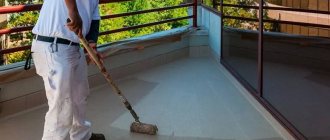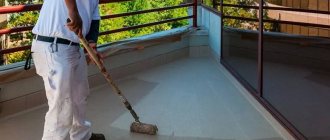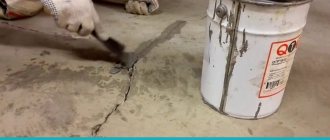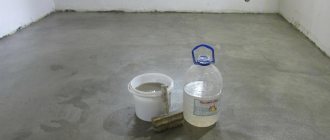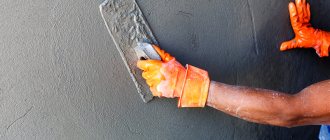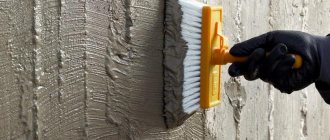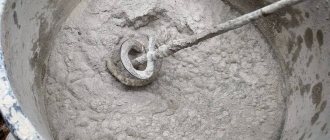Let's understand what liquid glass is. What does it consist of and what are the main advantages. Read to the end and learn everything about this material - from the formula to its use in construction. This information will allow you to “not swim” in matters of liquid glass for concrete or wood when concluding an agreement with a construction company. This will also help optimize construction costs without compromising quality.
Sodium silicate adhesive for concrete surfaces Source 55elmirador.com
Using ZhS
The use of liquid glass in construction is due to its qualitative properties. It increases water resistance, which is especially important when constructing foundations for hydrological structures (fountain, pool, etc.). It also increases the heat-resistant qualities of bases for stoves, fireplaces and other heating devices.
Coating insulation of the pool bowl with glue Source dm-art-design.ru
The more liquid glass you add to concrete, the faster it will set, for example:
- if the material is 2%, then you can walk on the solution after a day;
- at 10% – after 6 hours.
Excellent waterproofing and heat-resistant mixtures are prepared from this glue. The primer is made from cement, water and liquid glass. Excellent insulation is obtained from glue and sand. The use of liquid glass has shown excellent results on the walls of wells, wet tunnels and basements.
The refractory mixture is made from sand and cement with the addition of office glue. The walls of the fireplace and stove are treated with it using a wide brush. In addition, you can use liquid glass for wood in the form of an antiseptic. To do this, the glue should be diluted with water.
Wood treated with glue Source www.cedar-stuff.com
Liquid glass is applied to a vertical surface in an even layer using a regular paint brush; on a horizontal surface it is easier to pour it and spread it with a squeegee or spatula. If the coating with liquid glass is supposed to be double-coated, then the first layer must dry completely.
Liquid glass - what is it?
This term refers to a water-soluble mixture of potassium or sodium silicates. Lithium silicates are used for electrode coating. The material has a viscous structure and consists of tiny crystals. When they hit the surface, they increase in size and fill microscopic cracks and pores. This creates a water-repellent and heat-resistant layer.
Penetrating waterproofing: applying a solution with LC Source obustroeno.com
The formulas of liquid glass or silicate glue are as follows: K2O(SiO2)n or Na2O(SiO2)n.
This glue was first obtained by the German mineralogist and chemist Jan Nepomuk von Fuchs in 1818 by the action of alkali on silicic acid. In addition to waterproof concrete and cement, potassium or sodium liquid glass is used for:
- preparing fireproof paint;
- gluing linoleum and PVC boards;
- self-leveling floors;
- antipyrrhenes for wood;
- impregnation of fabrics;
- securing weak soil;
- cellulose gluing.
If you add liquid glass to a cement solution, then after hardening you will get a very durable monolith.
What is the material
Silicate glue or, as it is otherwise called, liquid glass is an aqueous solution of silicate salts. Depending on the main component there are:
- sodium liquid glass, characterized by a high degree of adhesiveness, fire resistance, antiseptic and waterproofing properties;
- potassium, which is immune to atmospheric influences and acid attack.
Soda glass is used to accelerate the hardening process of cement mixtures due to the chemical reaction that occurs.
Liquid glass has become widespread as a construction and finishing material due to its properties:
- Hydrophobic (water-repellent). Thanks to this property, liquid glass is used to treat surfaces exposed to prolonged contact with liquid, including wood products. As a result of impregnation, they will not be subject to swelling and deformation.
- Antiseptic. This property allows the use of silicate glue for protective impregnation of walls against such negative manifestations as mold and mildew.
- Fireproof. Impregnating floors and walls with liquid glass increases the fire safety of the room.
- Antistatic. The material eliminates electrification and does not provoke the occurrence of static electricity.
- Acid-resistant. Impregnation with a silicate solution helps protect the surface from exposure to chemicals.
- Eco-friendly. This material does not emit substances harmful to the human body.
Proportions and mixing
Depending on the purpose of use, the proportions of the various components of the solution are chosen. Ready-made mixtures intended for a particular task are more expensive, so solutions prepared directly at a construction site are often used.
Stationery glue on the floor Source fundamentplus.com
Composition for coloring
The effect of silicates on coloring pigments significantly limits the number of shades. Potassium silicate is used to prepare coloring compositions - it gives a more uniform color, unlike sodium. Such dyes are produced in ready-made versions; you only need to combine 2 components.
See also: Projects of houses with second light
Primer
To get a good primer, glue and cement should be taken in equal quantities. This coating will significantly strengthen the concrete foundation. Lighter solutions are made for tiles.
Impregnation
To increase the service life of elements and structures, an aqueous adhesive solution is used in a ratio of 1/5. Impregnate with a spray gun or brush. Small items can be completely immersed in the mixture.
Waterproofing
To protect concrete from water, prepare a solution of sand, cement and glue in equal parts. Water is added until the mass becomes homogeneous and plastic.
Fire protection
Masonry mortar with heat-resistant properties consists of cement and sand in a ratio of 1/3. Water is added until a plastic consistency is obtained, silicate glue is added last and makes up approximately 20% of the mass.
Video description
In the video, testing wood treated with liquid glass for combustibility:
Antiseptic
To prevent rotting and damage to surfaces by fungus and mold, structures are treated with liquid glass diluted with water in a ratio of 1/1. Use glue for processing concrete and wood.
Repair composition
Liquid glass, cement and sand are taken in a ratio of 1/1/3. Water is added until a sufficiently thick consistency is obtained so that the solution does not flow out of the cracks when they are eliminated. The mixture is also used when sealing joints and pouring screeds.
Mixing the solution
To properly mix a solution using liquid glass, you must follow the recommendations for certain mixtures for treating and repairing surfaces. Dry ingredients and glue with water are mixed separately.
Screed with ZhS Source i9.photo.2gis.com
See also: Specialize in the design and construction of small forms
Dry components are added in parts to the solution, and not vice versa. For greater plasticity, the volume of water is increased. The mixture is applied to the surface, taking into account finishing technologies.
Increased waterproof and heat resistance
A solution with liquid glass reduces the porosity of the composition and increases water resistance. Concrete structures and reinforced concrete products when exposed to high humidity become vulnerable to mold and mildew. Due to the antiseptic effect of glass, it should be used in places in contact with water, this will protect against the formation of mold.
Such a composition can be prepared only by adding a small concentration of the solution - 3% of the total volume. It is preferable to combine with coarse cements. Mix cement in the specified proportion, otherwise, when the silicate composition is washed out of the concrete, it will lose some of its strength characteristics and become vulnerable to moisture.
The additive is used to produce heat-resistant artificial stone. If you expose standard concrete to heat, around 200°C, the material will begin to deteriorate. If you add 1 liter of quartz solution to 3-3.5 liters of cement, the heat resistance increases to 1000-1400°C, which is used for hardening decorative stone. In the process of calculating the production of facing stone, 29-34% is allocated to liquid glass.
The composition must be added when laying blocks in industrial facilities, private construction: construction of fireplaces, chimneys, stoves.
Application of liquid glass
When working with potassium or sodium liquid glass, you should use protective equipment - a special suit and mask. If the mixture gets into your eyes or skin, rinse with plenty of water. Since the solution sets quickly enough - within 30 minutes, you need to calculate the one-time volume of the batch. After half an hour, you can apply the next layer.
Basement waterproofing
The basement is an important structure, so protecting it from moisture is the main condition for a favorable atmosphere in the house and the safety of food. Most often in the basement there is poor insulation of joints and the presence of cracks.
Basement insulation diagram Source moydomik.net
To get rid of them:
- first clean the seams and cracks from various inclusions and dust;
- then prepare a solution of silicate glue and cement in a ratio of 1/20, add water until a plastic consistency is obtained;
- then apply the mixture to the seams or cracks and level them with the same solution;
- After this, coat with water using a brush.
After a day, it is better to apply a layer of glue to the repair site.
Treatment of a concrete well, swimming pool
First, the concrete is cleaned with a brush to remove dirt and dust. After this, apply one layer of impregnation with a roller or brush. After half an hour, apply the second layer. Liquid glass should lie evenly, without gaps. Then prepare a solution from a cement mixture and silicate glue in a ratio of 9/1 and apply it with a spatula in 20 minutes, taking into account the low viability of the solution.
Safety precautions during operation
It is recommended to wear rubber gloves and boots when applying glass waterproofing coating.
When diluting liquid glass, a strong alkaline reaction occurs, so you need to prepare a large container with clean water and vinegar.
A weak vinegar solution will neutralize the alkali if it comes into contact with the skin.
When pouring a glass coating, you need to protect the room from drafts. To do this, do not turn on the air conditioner and heating devices until the base is completely dry.
General recommendations for treating concrete bases with liquid glass
The work of processing the concrete base is done quickly - the ready-made liquid silicate adhesive can simply be mixed using a construction mixer. Work should be carried out at temperatures above plus 5 degrees. After collecting the glue, the container is tightly closed. And :
- there is no need to treat external surfaces if frost is expected;
- if there is ice or frost on the base, no work is carried out;
- When processing horizontal areas, puddles are unacceptable.
Any surface must be properly prepared - silicate glue is applied only to dry and clean surfaces. The top loose layer (ironization and cement laitance) is removed using various tools and units. For large areas - this is a grinding machine, sandblasting and shot blasting machine. For hard-to-reach places and in junction areas - hand tools. The resulting sludge and debris are cleaned out with stiff brushes and a construction vacuum cleaner.
Cleaning up garbage with a construction vacuum cleaner Source kwitka.com.ua
Floor waterproofing
Waterproofing with this material allows you to obtain a surface that is impermeable to water and air.
Sequence of surface preparation work:
- We prepare the surface, remove all loose building materials, paint, rust, oil stains and other contaminants from it.
- We sand the surface with a stiff wire brush or sandpaper.
- Remove dust using a powerful vacuum cleaner.
We take into account that it is problematic to apply plaster or putty on a glass floor, since they will not adhere to the surface.
Apply the diluted liquid glass in several layers.
Advantages and disadvantages
Liquid glass has its advantages and disadvantages. The first include:
- low cost;
- low consumption of glue in solutions;
- resistance to precipitation;
- ease of use;
- good adhesion (penetrates 2-3 mm into concrete);
- durability of concrete and protective film.
Along with this, silicate adhesive prevents the accumulation of static electricity and is resistant to acids.
Protective film on wood countertops Source woodspil.ru
Along with the advantages, the material also has disadvantages:
- The protective film is not strong enough and is destroyed by mechanical stress.
- Not applicable on brick.
- When waterproofing the foundations of buildings and structures, rapid crystallization of the composition with the addition of LC occurs.
If the proportions of components in solutions are not observed, it is impossible to obtain the expected result.
Ensuring safety precautions
The glue is non-toxic, non-flammable and non-explosive. The prepared mixtures are stored in a dry, cool place at a positive temperature of 5 to 40 degrees.
Safety precautions and precautions Source beton-house.com
Silicate glass is frost-resistant and can withstand temperatures down to minus 34 degrees. The material can withstand 5 freeze/thaw cycles without losing its consumer properties. Should not be placed near heating devices or operating equipment. Residues must be disposed of correctly - do not pour into water bodies, soil or sewers.
Material characteristics
What is liquid glass? In scientific terms, this is a solution of sodium silicate and potassium silicate, that is, the building material in question contains the same components as ordinary glass. Another name for this material is silicate glue, which makes its use immediately clear.
Liquid glass has very high adhesive properties and is characterized by thermal conductivity - this material is often used in thermal insulation work. The insulation, in the manufacturing process of which liquid glass was used, can withstand temperatures of up to 1200 degrees Celsius!
Where to order JS?
Searching and choosing a store or supplier of liquid glass directly depends on the required volumes for your goals and objectives.
In small quantities it can be found in construction markets, hypermarkets or on websites.
But if you need to purchase sodium liquid glass in large volumes of 1 ton or more according to individual characteristics, you must contact federal manufacturers, for example, the Promsteklocenter company. According to the information posted by this manufacturer, it produces and supplies silicate products throughout Russia and the CIS in any container and by any transport, and also owns its own laboratory, which guarantees high quality of the product.
So is it worth the bother?
Making liquid glass with your own hands is not justified (purely our opinion). This requires serious knowledge, complex reagents and equipment. It is also important to know the correct composition of such a polish.
It’s easier to buy the product and do the work yourself, without going to a car service (it’s cheaper).
As you have seen, this is not difficult to do, the main thing is to adhere to the rules that we described above.
If you managed to make liquid glass, write about it in the comments, everyone will be interested in how you managed to do it.
